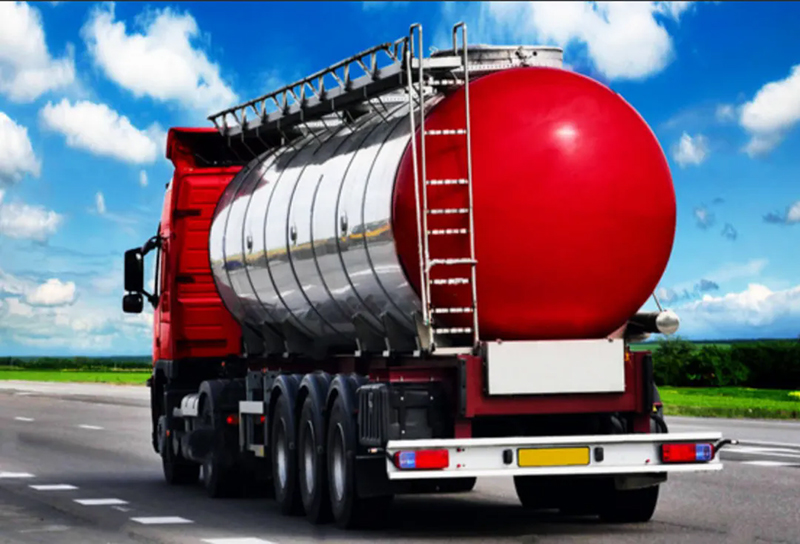危化品运输注意事项及自救指南!
Source: Yongkang Zhongyi Manufacture & Trade Co., Ltd.Publication time:2025-07-04
Leakage, combustion, explosion - the high risk of hazardous chemical transportation is self-evident. According to statistics, 77% of hazardous chemical accidents in China in recent years have occurred during transportation, and the consequences are often very serious. How to ensure the safety of hazardous chemical transportation? How to self rescue after an accident? This article will provide you with a detailed explanation of relevant precautions and self rescue guidelines, helping you stay alert at all times and achieve safe transportation.
Precautions for transportation of hazardous chemicals
Hazardous chemicals "are a general term for flammable, explosive, and highly corrosive substances, and the transportation of hazardous chemicals also poses certain risks due to their transportation characteristics.

What should be noted before transporting hazardous chemicals?
1. Vehicle inspection: In addition to daily maintenance and safety checks, hazardous chemical transport vehicles should also strengthen vehicle self inspection before transporting hazardous chemicals to prevent them from carrying "diseases" on the road. At the same time, it is important to check whether the vehicle signs and markings are complete.
2. Packaging hazardous chemicals: Before shipment, they should be packaged in a safe manner based on their properties, transportation distance, and road conditions along the way. The packaging must be firm and tight, with clear, standardized, and easily recognizable markings on the packaging.
3. Standardize the loading of goods: Dangerous chemical goods should be loaded evenly and balanced, and fixed as a whole, achieving one truck, one cargo. Different hazardous chemicals cannot be mixed together, and there should be no gaps between barrels. Fire arresters should be installed in car exhaust pipes, and grass mats should be laid in iron floor carriages. After loading hazardous chemicals, the vehicle escort personnel should not only carry the manifest with them, but also record and carry in writing the name, characteristics, quantity, disposal method, and contact information of the consignor in detail, so as to respond to and handle emergencies at any time.
What should be noted during the transportation of hazardous chemicals?
1. Choose a driving route: When transporting hazardous chemicals, try to choose national highways or expressways that are far away from towns and residential areas and have smooth roads. Do not drive on roads with complex situations, and do not park, rest, or eat on city streets or residential areas. Especially for hazardous chemical tank vehicles, as all tanks are exposed, it is recommended to rest during the day and drive at night in hot weather to prevent liquid expansion. In case of inclement weather such as rain, fog, ice, and snow, try not to arrange for transportation.
2. Selection of parking location: Attention should be paid to parking vehicles loaded with hazardous chemicals in schools, markets, famous scenic spots, tourist areas, etc. If loading and unloading operations or temporary parking must be carried out in the above areas, safety measures should be taken and the consent of relevant local departments should be obtained. When parking, someone should be left to guard and unauthorized personnel are not allowed to approach the vehicle. Ensure that the vehicle is in the presence of people to ensure its safety.
3. Safe driving: Vehicles must strictly comply with traffic, fire, public security and other regulations during operation. The speed should be controlled, the distance from the preceding vehicle should be maintained, and in case of emergency, deceleration should be made in advance to avoid emergency braking. Overtaking in violation of regulations is strictly prohibited to ensure driving safety. When driving on highways, one must follow the designated lane and not overtake or change lanes at will. When encountering severe weather conditions such as rain, fog, ice, and snow, it is necessary to increase the distance. If the vehicle slips, do not forcefully turn in the direction.
4. Frequent inspections during driving: The safety hazards of hazardous chemical transportation begin with leaks. Due to the bumps and vibrations of the vehicle during driving, it is often easy to cause packaging damage, which is often concentrated in three points: the bucket lid is not tightened or the sealing ring is ineffective; The welds and ribs of the iron drum are damaged due to friction; The displacement of the bucket bottom during driving caused damage. Therefore, every two hours of driving, check if there is any overflow on the bucket lid and tighten it again with a special wrench. If the sealing ring is ineffective, replace it; Whether the filling material between the iron drums has fallen; Is there any liquid leakage around the bottom of the carriage? If so, the leaking bucket should be identified and the leak point should be facing upwards; Whether the tied ropes are loose, etc. It is worth noting that during the high temperature season, the liquid will expand. When replacing the sealing ring, it should be slowly opened until the gas is released before fully opening it to avoid opening the cover too quickly and causing injury from liquid spraying out.
5. Strengthen emergency response: In the event of a leak or other situation during transportation that cannot be saved by personal efforts, it is necessary to quickly move to an open area and stay away from crowds and water sources. Especially on highways, vehicles should be quickly moved to emergency stop zones, warning areas should be set up in a standardized manner, and the police should be immediately alerted. When reporting an alarm, the name, characteristics, quantity, and leakage of hazardous chemicals should be explained in detail to facilitate effective disposal by rescue personnel in a timely manner.
What should be noted after the transportation of hazardous chemicals?
1. Be careful when unloading to prevent contamination. Hazardous chemicals are toxic and corrosive, and if not taken seriously, they can easily pollute the environment, especially liquid products that can contaminate land and water sources. After long-distance transportation, the outer packaging of hazardous chemicals has some damage, so special attention should be paid when unloading. Where there is no dedicated platform, a springboard or wooden bar should be laid, and a rope should be used to pull the bucket slowly to the ground, or waste tires should be used to cushion the ground. At the same time, users should be aware that hazardous chemicals should be stored for a period of time until their performance stabilizes before use.
2. Clean and disinfect in a timely manner. After the completion of transportation operations, hazardous chemical transport vehicles should be cleaned and disinfected in a timely manner. During cleaning and disinfection, attention should be paid to the nature of the hazardous materials, and knowledge of cleaning and disinfection methods should be mastered to prevent accidents such as pollution, cross reactions, or poisoning.
How to self rescue after a hazardous chemical explosion?
Unlike ordinary explosions and fires, hazardous chemical explosions pose greater risks and are more likely to trigger chain explosions and the spread of harmful gases. So, in this sudden situation, how should ordinary people save themselves?

On site: Quickly evacuate in the upwind direction
Generally speaking, few people can remain calm when encountering such sudden explosions. The editor tells everyone that there is only one principle at this time: quickly evacuate towards the upwind direction, and be sure to firmly remember this one.
If the explosion is located in your upwind area, pay special attention: usually subconsciously, run away from the direction of the explosion point. If the gas after the explosion is toxic, it will always be on the path of the toxic gas. The correct way is to avoid the explosion point and evacuate towards the upwind direction.
Gas, due to its low density, is greatly affected by wind. A gentle breeze of 1-2 levels is enough to make the gas blow steadily in one direction, which can be recalled from the smoke emitted from a chimney. In other words, as long as there is a slight breeze, toxic gas should be used, and the upper air vent should be fully activated while the lower air vent should be ventilated, so never stay in the lower air vent. Remember, it's not the farther the better, it's the upwind!
What should nearby residents do?
1. Do not watch! Don't spontaneously organize to save people! Do not attack within the police cordon, as it may cause harm to yourself and disrupt the entire rescue process. Surrounding residents should also not go and watch, as the internal situation is uncertain. At least two explosions have already occurred, and there may be more explosions, with a potentially larger impact area.
2. Ensure traffic and obey commands! Make way for the passage, keep the rescue traffic clear, avoid concentrated areas, do not engage in spontaneous activities along the way, and do not watch the rescue. Ensuring traffic and obeying commands is the greatest contribution to saving lives.
3. Don't panic blindly, don't believe rumors! Timely watch, listen, and receive government notifications. If there are significant hidden dangers that will affect the surrounding environment, the government will notify everyone through official channels and make arrangements for their evacuation and relocation. Don't spread rumors easily to avoid excessive panic, and don't give up your home easily.
4. Stay calm and take protective measures! If you are not in a dangerous area, there is no need to panic, you can remain calm. If you are worried, you can do some self-examination within the allowed conditions, prepare some daily protective equipment, and if you are worried about chemical leakage, you can wear an activated carbon mask.
What do rescue personnel do?
Firstly, it is necessary to ensure personal safety before rescuing the injured. At present, the flames and high-temperature objects on site can cause certain harm to people, and if there are still flammable materials, there is a possibility of further explosions. Fragments and debris on site can cause secondary harm to rescue personnel. Be careful of all of these.
2. Emergency response based on the five injury mechanisms of the explosion:
(1) Barotrauma. The sudden expansion of gas will cause huge damage. For humans, prominent injuries include damage to the lungs, respiratory tract, throat, etc., causing hearing loss, tympanic membrane rupture, corneal damage, respiratory distress, respiratory failure, and in severe cases, death. There is no special rescue method available on site for this situation, and it can only be sent to the hospital as soon as possible for formal treatment.
(2) Fragmented injuries. The splashing of hard objects, such as building materials, flying directly onto people may cause surface damage and internal bleeding. If the surface of the human body is damaged and the artery is cut, it can cause life-threatening massive bleeding. Bleeding of more than 800ml can lead to shock. Bleeding is the most common cause of death in trauma. In this case, to find a way to stop the bleeding, you can use a handkerchief or towel to compress the bleeding, or make a tourniquet. Do not let the blood flow rapidly. If fragments enter the human body, it may cause internal bleeding in organs. If a hard piece penetrates the chest or lungs, it can cause pneumothorax. Plastic or plastic wrap (non breathable material) should be immediately used to seal and bandage it. Rescue personnel have professional chest patches.
(3) Impact injury. The gas expansion caused by the explosion lifts people up and collides them with hard surfaces or sharp objects, causing them to fall to the ground and cause injuries. The pancreas, spleen, and brain tissues are relatively fragile tissues, and wounds are usually not visible on the surface, but the consequences are serious. Once missed, surgery may not be possible in time, so do not misdiagnosis or miss diagnosis. A simple inspection method is to observe the surface of the body to see if there are any conditions such as cold hands and feet, pale complexion, etc. Press the nail bed (the skin covered by human nails or toenails). If it turns white after pressing, it is normal to immediately turn red after releasing it. If it does not recover for two seconds, it may be a problem.
(4) Burn and scald. Generally, explosions are accompanied by high temperatures. The early treatment is to rinse with cold water. If it is a small burn, rinse with cold water from the center to the surrounding area of the wound. It is best to soak a large area burn in clean water, but not for too long. Simple protection is to cover the wound surface with plastic wrap, as the gauze may adhere to the tissue, causing pain and secondary damage when removed. And for large burns, a sheet can be wrapped around the body surface. Be careful not to apply "folk remedies" such as soy sauce, vinegar, toothpaste, rapeseed oil, aloe vera gel, etc. 1、 These are ineffective. Secondly, their color can cause doctors to make misjudgments. Thirdly, these "foods" may pose a risk of infection because the skin after burns does not have the ability to resist bacteria.
(5) Explosives themselves: Hazardous chemicals causing harm. If not fully burned, the residue can cause significant damage. The first aid method is to rinse with water, called "washout", in simple terms, to take a shower and thoroughly clean the body, which can prevent 90% of chemical and radioactive damage. Dust on the body may contain chemical residues, so it is important to take a thorough shower when returning home to avoid prolonged exposure to chemicals.
What should survivors do on site?
1. Stay calm: Be sure to stay calm, as impatience can reduce resistance and increase oxygen consumption.
2. Safe transfer: Observe the surrounding environment and transfer yourself to a safe place. Do not move blindly to avoid aggravating the injury.
3. Timely adjustment: Adjust one's various vital signs in a timely manner, conduct self-examination of the body, and find ways to clean up any sediment in the mouth and nose. Check if there is heavy bleeding in the body, all you can do is stop the bleeding. If there is blood coming out of the "whoosh", be sure to find a way to stop the bleeding, such as pressing or tearing clothes, towels, sheets, etc. to make a "tourniquet" for yourself.
4. Correct call for help: Do not blindly shout continuously. You can find something to knock on or shout indirectly to maintain physical strength.
5. Ensure breathing: Fires are usually accompanied by thick smoke, which contains chemicals. You can use a handkerchief or towel dipped in it to cover your mouth and nose, because smoke is lighter than air and is safer at 30-60 centimeters, which is about the half squatting position of an adult.
Source: Laboratory Safety Management Notes





